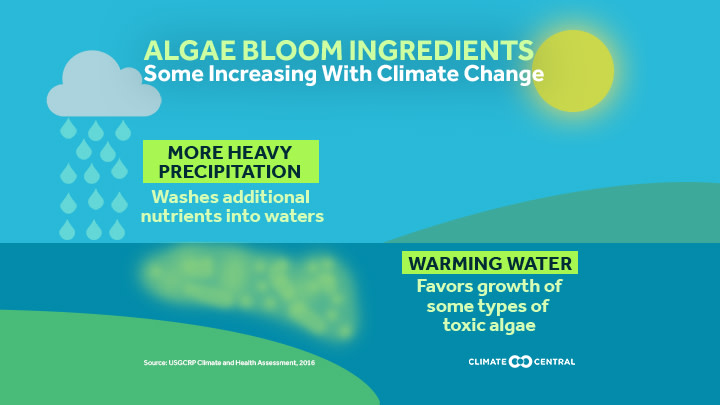Algae occur naturally in most bodies of freshwater and saltwater. It’s normally fairly harmless, but the right combination of warm water, high nutrient levels, and adequate sunlight combined can cause a harmful algae bloom. These blooms can damage aquatic ecosystems by blocking sunlight and depleting oxygen that other organisms need to survive. Some algae, like red algae and blue-green algae, can produce toxins that damage the human nervous system and the liver (and they also stink — literally).
Recently, there has been an increase in algae blooms globally, and climate change may be playing a role. Warmer water allows some harmful types of algae to grow faster than other, more benign varieties. This warmer surface water also prevents water from mixing vertically, allowing algae to grow thicker and faster. This sets up a feedback loop: water made darker by the presence of the blooms absorbs more sunlight, warming even more, and enhancing the conditions for more blooms.
Global warming takes place in the ocean too, and rising ocean temperatures have been found to be partially responsible for more intense algae blooms in the North Atlantic, while warming lakes have played a role in the increased frequency of algae blooms in some inland waters of the U.S.
Increasing heavy precipitation — another impact of climate change — can wash more agricultural fertilizers into bodies of water, providing nutrients for the algae to thrive. And in a supercharged water cycle, the droughts that follow heavy precipitation will allow more water to evaporate from the surface, concentrating the nutrients and giving the algae the opportunity to survive longer and multiply more.
The blooms don’t just smell bad, they impact human health both directly and indirectly. The toxins produced by certain algae can cause eye and lung irritation and worsen asthma. Fish and shellfish can become contaminated, and when eaten, can cause gastrointestinal pain or even neurological illnesses.
